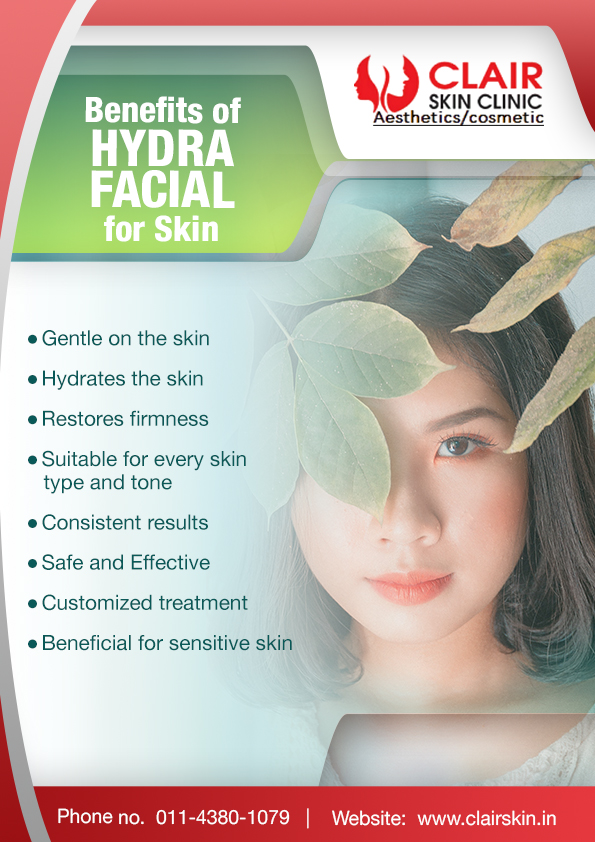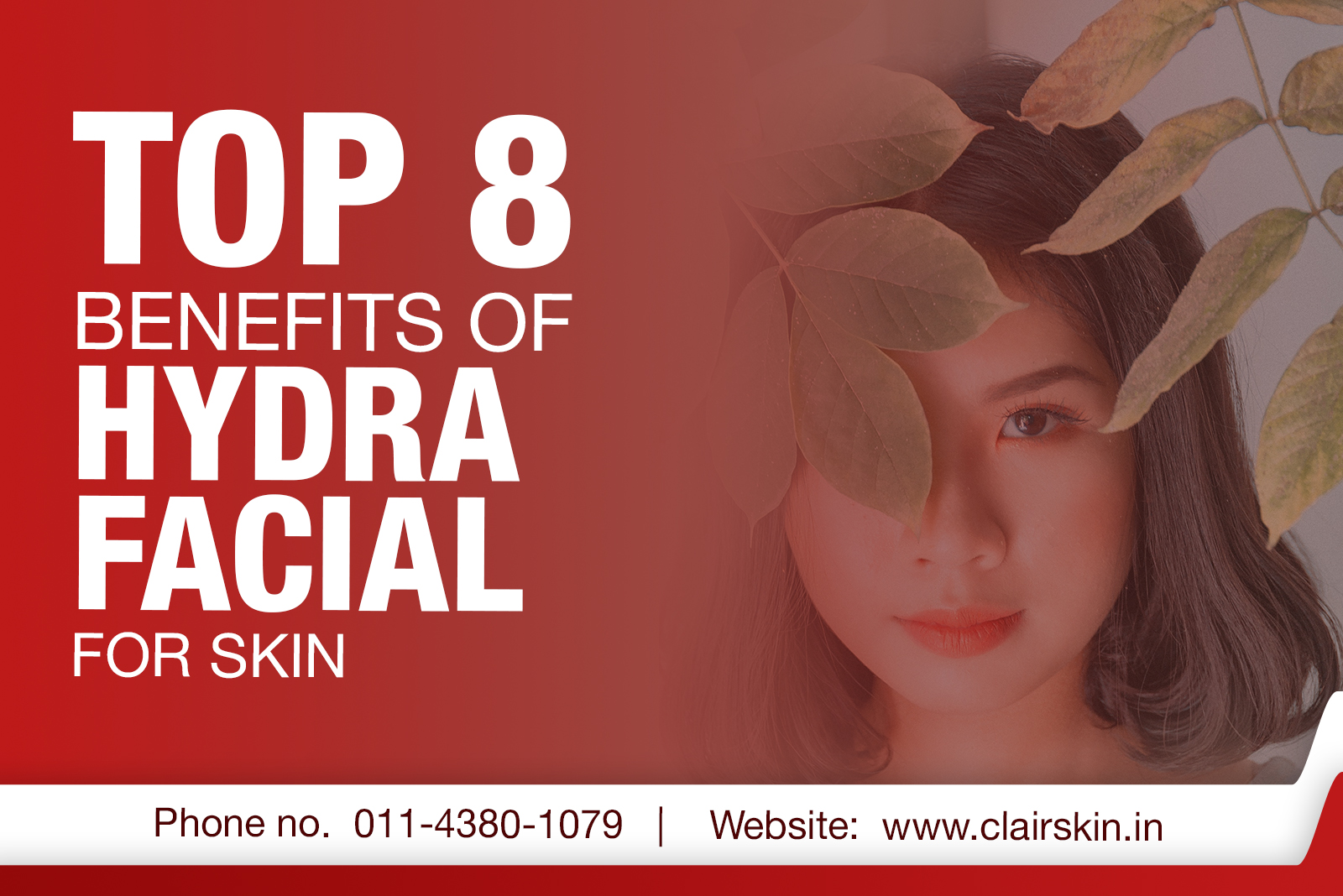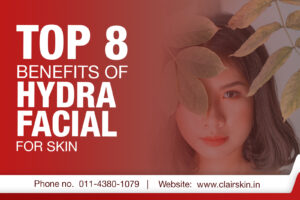Table of contents:
Feel Free to skip ahead if one topic catches your eye
- 1. What Is Hydrafacial?
- 2. What Are The Benefits Of Hydrafacial
- 3. What Does Hydrafacial Do for Your Skin?
- 4. What can be the side effects of Hydrafacial, how to avoid it?
- 5. What Can Be the Side Effects of HydraFacial?
- 6. How to Avoid HydraFacial Side Effects: Aftercare Steps
- 7. Take Away
- 8. FAQs
1. What is HydraFacial?
A HydraFacial is a cosmetic procedure that uses special devices to cleanse and hydrate your skin. It usually uses patented technology to clean the pores and get rid of the skin's dead skin cells.
The treatment starts with loosening and opening the pores and then prepping the skin using a mix of glycolic acid, salicylic acid, and several botanical ingredients for better cleansing.
Once the pores are open enough, the professional uses vacuum-powered extraction equipment that gets rid of the dirt and oils clogged inside the pores. It is a non-invasive procedure and is practically painless.
Also Read- HydraFacial- Process And Benefits

2. What are the benefits of Hydrafacial?
Here are a few benefits you can experience after this treatment.
- Gentle on the skin
- Hydrates the skin
- Restores firmness
- Suited for every skin type and tone
- Consistent results
- Safe and Effective
- Customizable treatment
- Amazing for sensitive skin
Also Read- Hydrafacial Vs Regular Facial: Which Is Better?
3. What Does Hydrafacial Do for Your Skin?
As mentioned before, hydrafacial is a three-step cosmetic treatment that involves cleansing, exfoliating, and hydration of the skin. Here is what you can expect from the process and what it does to your skin.
- Cleansing:
- Chemical peeling:
- Extraction:
- Hydrating Serum:
Also Read- Does Hydrafacial Work For Acne?
4. What can be the side effects of Hydrafacial, how to avoid it?
HydraFacial is one of the top choices and most effective skin treatments that make your skin look flawless. The treatment is known to have many benefits and can treat a wide range of skin issues, from hyperpigmentation to acne.
What’s more, the side effects of hydrafacial treatment are minimal compared to other skin treatments, making it a dependable skincare option. However, you may find some hydrafacial side effects that come up if you don’t take care of the skin properly after the treatment.
5. What Can Be the Side Effects of HydraFacial?
HydraFacial treatment involves the use of a mechanized wand that slowly infiltrates your skin with customized serums to provide desired results. It is a non-invasive procedure that usually only takes 30 minutes or less to complete. The procedure can help exfoliate, deep-clean, and hydrate your skin. As a result, you can prevent and treat skin conditions like dryness, dark spots, fine lines, wrinkles, and acne. However, when opting for a HydraFacial near me, ensure you get it done by a professional.
Although it has numerous benefits, hydrafacial side effects are a possibility but on a minimal scale. The HydraFacial procedure is not designed to hurt or make your skin red, unlike other cosmetic procedures. However, as you feel a little bit of wand pressure during the procedure, it can leave temporary redness on your skin. Usually minor and going away on its own, this is one of the sole side effects of a HydraFacial treatment.
Moreover, if you have an active rash, such as one brought on by a rosacea flare, you should refrain from this treatment. The serum or other items used during a HydraFacial procedure may, in extremely rare circumstances, cause an allergic response in a patient. By searching for a hydrafacial near me and choosing a top-rated clinic, you can easily avoid it as the procedure will be done by an experienced dermatologist.
6. How to Avoid HydraFacial Side Effects: Aftercare Steps.
Since hydrafacial side effects are almost non-existent, you can still avoid irritation or unnecessary complications that may arise from improper care. Here’s what you can do to take care of your skin after a HydraFacial treatment.
- Avoid Picking at Your Skin
Avoid picking at your skin because it has just had a deep cleaning. You should not pick at your skin on normal days, too but take special care right after the treatment. Keep your hands off if you want a perfect appearance, even if you might be tempted to pop the little whitehead and blackhead that are destroying your complexion. Even if the cosmetic specialist extracted some hairs, irritating your skin further might result in discomfort. This can also help you avoid the side effects of hydrafacial treatment.
- Avoid Water and Workout
After your treatment, you should wait around six hours before washing your face. You should also refrain from taking a shower or working out vigorously enough to make you perspire. Moreover, if you are thinking, let’s hit the gym after getting hydrafacial near me, it’s not a good idea. Workouts can make your exfoliated skin feel overburdened by excessive heat and perspiration. You will preserve your skin and get the best benefits if you keep your face dry throughout this period.
- Remove the Toner for a Day
After receiving a hydra derma facial, avoid using the toner the day after. This is because dryness and irritation might be caused by toners with alcohol or exfoliating ingredients. This can lead you to think of them as hydrafacial side effects. Moreover, you don't need to apply a toner because the aesthetician must have already deep-cleansed your face and adjusted the pH.
- Change Your Skincare Regimen
The physical manipulation and the serums employed in the hydra derma facial might damage the skin barrier. So, you should not use anything harsh on the skin. You can use only mild cleansers to avoid damaging your skin's barrier while cleansing. Over the following two days, avoid using cosmetics that include glycolic acid or other substances that exfoliate your skin. Moreover, you should wait two weeks before getting a microdermabrasion, chemical peel, or dermaplaning procedure to prevent any hydrafacial side effects.
- Use Sunscreen
For at least a week, you should apply strong sunscreen to protect the tissues on your face. Throughout the following 14 days, you should also refrain from spending a lot of time in the sun. This can help you prevent unwanted side effects of hydrafacial treatment. Moreover, avoid tanning beds as they can hurt the skin, and newly formed skin cells that have never been exposed to sunlight are particularly vulnerable. As your face will be more sensitive than usual after a HydraFacial, a minimum of five days should pass without exposure to direct sunshine.
- Refrain From Having Facial Waxing and Laser Treatments
The skin renews itself in an average of 28 to 32 days. Therefore, you shouldn't get a chemical peel or a laser procedure within the first month after undergoing a HydraFacial treatment. Depending on the degree of exfoliation, your esthetician will decide if it’s all right to have hair removal procedures on your face. It's advisable to hold off for at least a week. Waxing exfoliates the skin, and overdoing it might make you appear dull rather than radiant. It will also help you avoid unwarranted hydrafacial side effects.
Also Read- Pros And Cons Of Investing In HydraFacial Treatment Cost
7. Take Away
The benefits of hydrafacial for skin are more effective than those of a basic spa facial. Not only does it help hydrate and moisturize the skin, but it also restores the lost shine and glow on your skin. It also helps treat conditions like acne and pimples too. Just ensure that you consult a certified professional for the treatment.
8. FAQs
1. How long do results last after HydraFacial?
Well, the answer to this question is a little tricky. Yes, because the result varies from person to person. Usually, the effect of HydraFacial lasts for at least 7 days. Sometimes it may last longer the usual. However, its duration can be increased with additional treatment. For this, you should consult us at +91-8447915975.
2. How often should I get HydraFacial done?
Once every 4 weeks. Yes, according to the expert at Clair Skin, you should get HydraFacial done in every 4 weeks. Although this frequency can vary, getting your HydraFacial treatment done once a month is good for skin boosting.
3. Does HydraFacial give a glow?
Yes, absolutely!! HydraFacial improves your overall skin texture, tone, and appearance. The deep exfoliation cleans your pores, removes the dead skin cells, and allows better penetration of face serums. Thus, it results in healthy, soft, and glowing skin
4. Is HydraFacial better than a regular facial?
A regular facial may hurt, but HydraFacial is just a gentle massage on your face, which can be enjoyable. Apart from this, it makes your skin smooth and glowing. There are multiple other benefits of HydraFacial,
5. Exactly how does a HydraFacial work?
Dead skin cells are removed from the surface of your face using suction and an exfoliating tip of the HydraFacial device. Exfoliation, washing, extraction, and hydration are all part of the treatment that the device delivers. This method cleanses and soothes your skin by using the vortex-spinning movement of the device. The treatment offers moisturization and removes dead skin, debris, and pollutants from the skin. Serums are applied to the skin after exfoliation, which gives you the signature radiance and brighter skin tone.
6. What are the other medifacial services clair skin provide?
The following are some of the medifacial services we provide:
- Hydrafacial Treatment
- Photo Facial
- Carbon Peel Treatment
- Vampire Facial
7. Is HydraFacial Good for Dry Skin?
Without a doubt, HydraFacials are beneficial for every skin type. With this non-invasive and quick effective technique, serums specialized to your skin type are delivered together with a deep clean and exfoliation using a motorized wand. In addition to delaying the growth of wrinkles, fine lines, and volume loss, hydra facials may help tighten, strengthen, and moisturize your skin in less time. You could be a great candidate for a HydraFacial treatment if you just sometimes or excessively experience dry skin.
8. Is HydraFacial Safe?
Most skin types, even the most sensitive ones, can benefit from hydra facials. However, HydraFacials should not be used by anybody with active rashes, sunburns, or rosacea since they may worsen the condition or induce flare-ups. With negligible adverse effects, the majority of patients handle HydraFacial therapy quite well. There may be some redness following a HydraFacial, which usually takes 30 minutes or less.
9. What are the Uses of HydraFacial?
A HydraFacial is a facial treatment that hydrates, cleanses, extracts, and exfoliates the face using exclusive equipment. Through a vortex-spinning movement, this system cleans and soothes your skin while removing pollutants, dead skin, and dirt. A HydraFacial is a three-step skin treatment that removes debris and dead skin cells using a kind of dermabrasion called hydra dermabrasion. Additionally, a patented tip is used in the therapy to produce a vortex effect that improves exfoliation. Applying peptides and vitamins gently to the skin is the last step of a HydraFacial.
10. What Does HydraFacial do to your Face?
A non-invasive in-office procedure called a HydraFacial can balance out skin tone, minimize wrinkles and fine lines, and enhance the texture of your skin. It can also assist with other problems such as premature ageing and skin dullness. One of the most effective non-invasive skin re-emerging procedures available today is a hydrafacial. It excludes pollutants and dead skin cells by combining cleaning, exfoliation, extraction, hydration, and antioxidant protection. It also infuses the skin with natural hydrating serums.





